Introduction: “Are you able to enhance the returns of this endowment portfolio?”
In late 2022, I grew to become a trustee of a non-public faculty endowment and was requested to hitch the funding committee. The committee consisted of a devoted group of trustees with prudent funding sense. Though there have been no everlasting staff to handle the funding, quite a few choices had made the job manageable. The endowment labored with a pointy monetary fiduciary who suggested after which carried out the committee’s choices.
Broadly talking, the endowment had adopted David Swensen’s Yale public mannequin. Market timing and inventory selecting have been fully prevented. Asset Allocation, or the apply of choosing deep, broad, main asset lessons was the modus operandi. The portfolio was made up of Vanguard funds invested within the Whole US Fairness Market, Worldwide Equities, Rising Market Equities, Public REITS, and the Bond Market Index Portfolio. Selecting passive Vanguard funds in main asset lessons stored the bills low, made monitoring simple, and allowed the portfolio to learn from the gradual grind-up in most belongings over time. Certain, there have been drawdowns when markets had a tantrum, however staying on track by not market timing prevented any panic choices.
As well as, each two months, the monetary middleman would rebalance the portfolio and benefit from sharp selloffs or rallies throughout asset lessons by shopping for the dips and promoting the rips. The portfolio was thus delivered to the goal allocation.
The chair of the endowment pulled me apart and stated, “You write for the Mutual Fund Observer! Is there something you’d advocate we do otherwise to generate increased returns?”
Allocation throughout asset lessons: I Spy a excessive allocation to worldwide equities!
Roughly, the portfolio was cut up up into these weights:
| US Inventory & some REITS | US Bond | Worldwide Shares | EM Inventory | Personal REITS & Personal Credit score | Money |
| 46.0% | 25.0% | 18.2% | 4.5% | 3.2% | 3.1% |
Instinctively, 18.2% for Worldwide Developed Market Shares, monitoring the MSCI EAFE Index benchmark, felt too excessive. (MSCI EAFE interprets to Morgan Stanley Capital Worldwide Europe, Australasia, and Far East Index.) I had began with a 15% weight to this class in my very own portfolio however in the previous couple of years introduced it right down to 4%.
Anybody who has learn David Swensen’s phenomenal guide on investing, Unconventional Success (2005) has learn the desk he recommended for example of asset allocation. This desk had Worldwide Equities at 15% and since then, folks suppose that the 15% quantity is written in stone. It’s not. Swensen’s recommendation was to determine what portfolio most closely fits the establishment’s strengths, different belongings, and future liabilities. In any case, I had began, like others with the 15% allocation to worldwide developed market equities round 2016.
Since then, I had been shocked by the decrease returns generated by Worldwide shares. I had satisfied myself that it simply meant there could be increased returns within the following years. However these increased returns by no means got here (no less than the passive worldwide benchmark didn’t convey excessive returns). I had puzzled why there was a return deficit.
I solely needed to ask as a result of I quickly discovered a plethora of causes to keep away from worldwide shares. Goldman Sachs’s Personal Wealth Administration has been operating a long-standing theme on US Preeminence since 2009 which laid out neatly how US shares have been going to beat the pants off their worldwide counterparts.
Worldwide inventory indices had decrease weighting in tech shares (in comparison with the US). The next weighting in banks and commodities. And subsequently, whereas worldwide indices seemed very low-cost on the floor, when adjusted for sector weights and in comparison with the US market, most of its cheapness went away.
In different phrases, if the Whole US Inventory market had the identical weight throughout sectors because the worldwide index, the US inventory market would additionally appear like it has a decrease PE a number of.
There have been different causes to keep away from worldwide shares. Within the Eighties and ’90s, there have been many currencies, and every Central Financial institution determined rate of interest and FX coverage to go well with their native economies. However by the 2010s and 2020s, with the appearance of the Euro, and an nearly coordinated world central financial institution rate of interest coverage, the financial cycles had merged. If the US went down, so did Europe and Japan. There was little divergence within the course of how economies fared, solely scales of magnitude differed. In such a world, there may be much less diversification.
US firms even have a a lot greater pool of managerial expertise to select from. US company administration is extra shareholder-focused. And, within the current age, a big quantity (maybe, 1 / 4) of US firms’ revenues come from international nations.
These qualitative causes have been adequate for me to confess that my 15% was too excessive and maybe 5% was a greater allocation to worldwide shares. I assumed the identical would apply to the endowment portfolio. Moreover making these subjective factors, I confirmed two charts to the funding committee.
10-year Whole Returns from 2013-2022
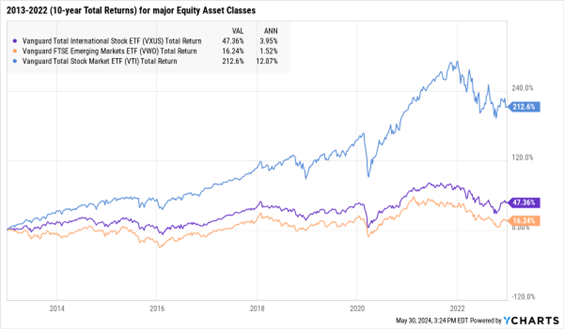
Whereas US equities returned 12% annualized within the 10 years from 2013 to 2022, worldwide shares returned 4%, and rising markets 1.5% every year.
Taking the chart again to 1996, confirmed 9.6% for the US, 4.9% for worldwide, and 5.5% for rising shares.
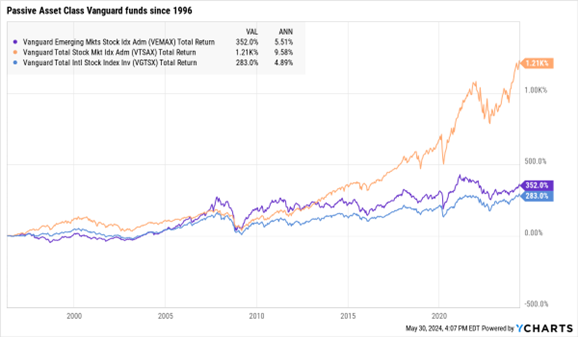
Trying on the information, I argued that the pure price of return for Worldwide Developed shares appears to be round 5% (for passively managed funds).
To which, an insightful committee member requested me, “Nicely, what ought to the worldwide allocation be?”
“Decrease than 18%,” I stated, considering I used to be sensible. “How about half the present allocation, or about 9%”
The issue with that reply is that it’s subjective. Why 9, why not 8 or 7 or 10 or 12?
“Our funding coverage requires we not be concerned in market timing.”
Checkmate.
Regardless that all of us agreed decreasing worldwide equities made sense, I wanted to research the issue and current a greater answer.
As I ate some humble pie after the committee assembly, I stored questioning find out how to “show” a decrease allocation made sense. It took me a number of days to understand that the proof required certainly one of Charlie Munger’s psychological fashions: Invert, at all times invert.
How did the endowment resolve to speculate 18.2% in worldwide shares within the first place?
“Funding Consultants” with 10-year Ahead Anticipated Returns
The endowment’s monetary middleman was tasked by the committee to resolve an asset allocation. The middleman labored with a third-party funding advisor (who shall stay unnamed). So referred to as consultants, yearly publish their 10-year Ahead Anticipated Returns for each asset class.
Geared up with Anticipated Returns and previous volatility for every asset, and correlation throughout belongings, monetary intermediaries run Monte Carlo simulations (a elaborate means of claiming they run 1000’s of pattern portfolios on the pc) to find out an “Environment friendly Frontier” for allocating capital throughout portfolios.
The Anticipated Ahead 10-year Returns, that’s, from 2023 to 2032 as recommended by that funding advisor have been:
| US Shares | Worldwide Inventory | Rising Shares | |
| 10-year Ahead Anticipated Returns | 6.70% | 8.88% | 10.80% |
That appeared loopy to me! Within the 28 years (since 1996) that these asset lessons have been tracked by Vanguard Funds, the precise returns earned by worldwide and rising have been HALF. How did the consultants give you these projections?
Enter the world of Cyclically Adjusted Earnings Yield. Right here’s our advisor’s clarification of the sport:
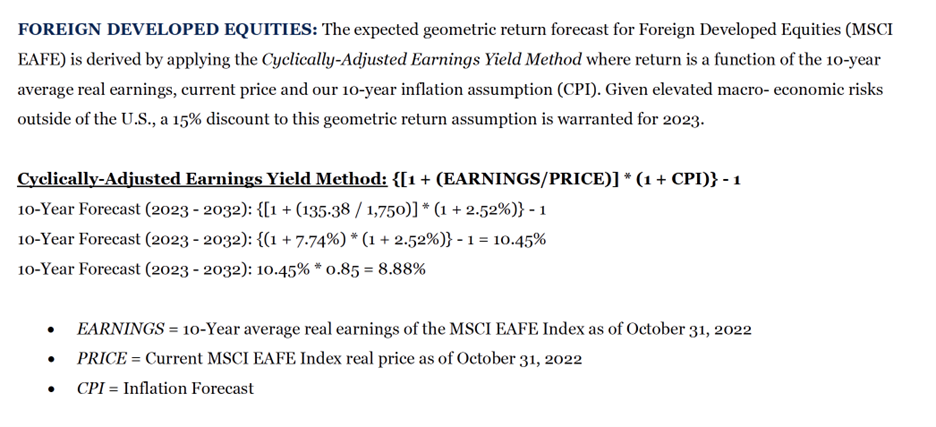
(I’m going to go away the supply out on goal)
The system is mainly combining:
- MSCI EAFE earnings (final 10 years of earnings adjusted for previous inflation) = 135.38
- costs (present as of end-2022): 1750
- inflation (anticipated ahead inflation): 2.5%
- International low cost of 15%
Put all of it collectively and magic. The advisor predicts 8.88% annualized return for MSCI EAFE for the following 10 years. Put that return quantity together with the Anticipated Return numbers for the opposite chosen belongings in a complicated monetary mannequin and also you get a portfolio allocation!
I’ve a wholesome respect for easy fashions. Significantly better to make use of a easy mannequin I can observe than a sophisticated one I can’t observe. However easy higher be proper. On this case, it’s not.
The funding advisor has been calling for returns for MSCI EAFE between 8 and 10% since 2008.
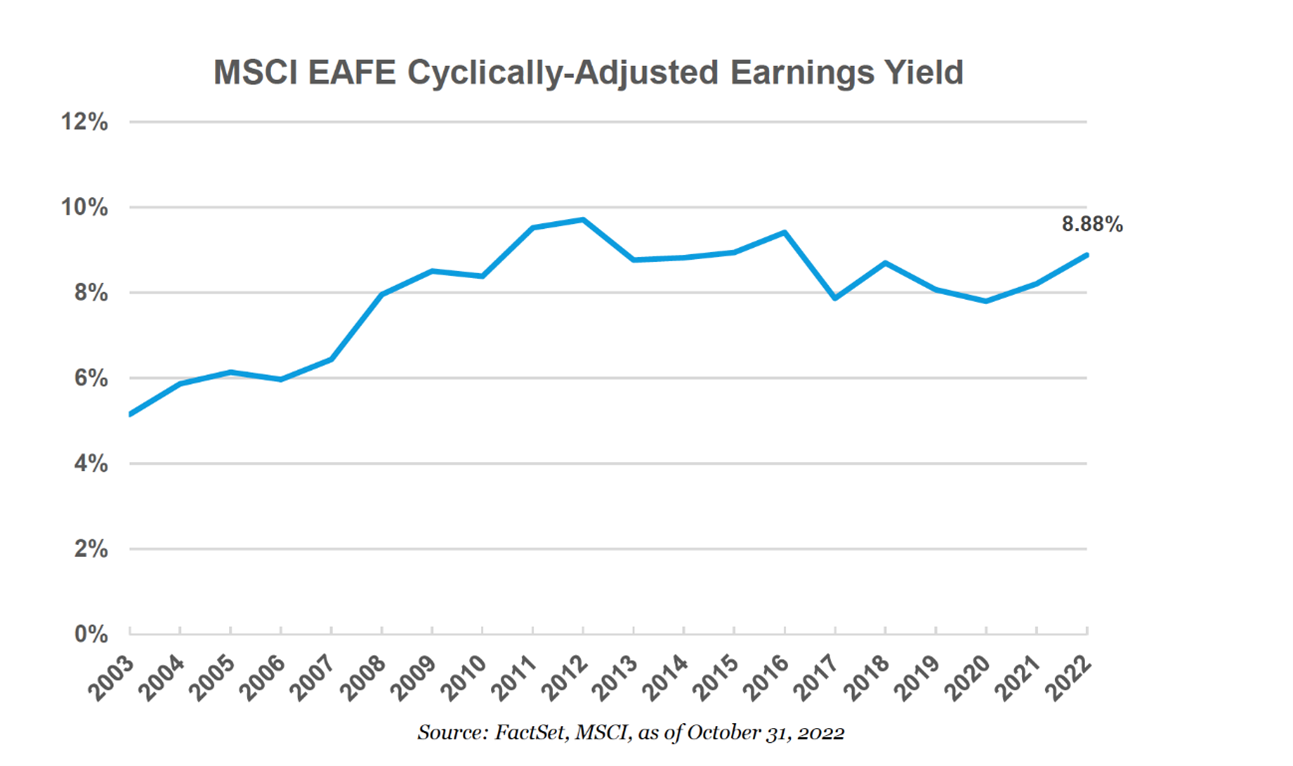
The precise return has been 1.7%!!! There isn’t a connection between the predictions of the funding advisor and actuality. Inverting the issue reveals the (passive) Emperor has no garments. Some actively managed funds targeted on worldwide shares are doing a lot, a lot better. However when funding committees resolve to pursue passive investing throughout the board, it’s as a result of they don’t need to select managers or shares. It is a drawback.
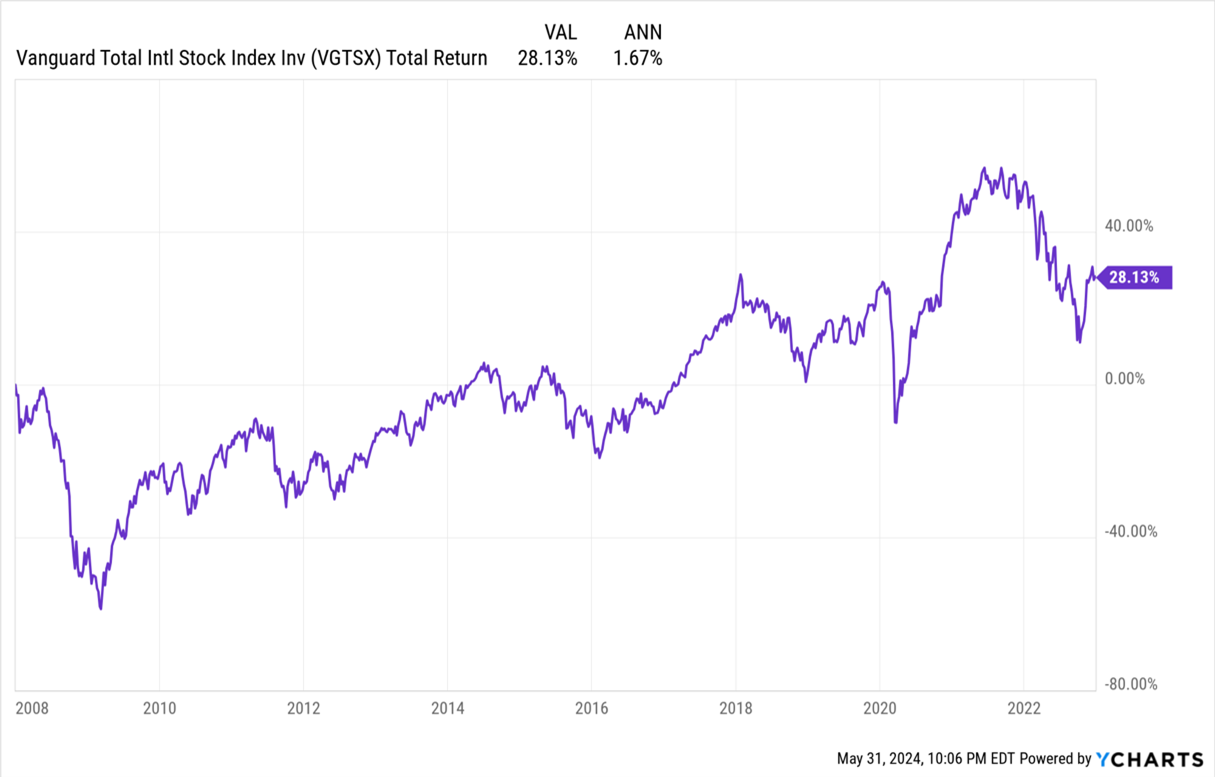
In keeping with MFO Premium $1.1 Trillion {dollars} are invested in passively managed index funds devoted to worldwide equities. These are among the largest:

I ponder what number of establishments across the nation are utilizing Ahead Anticipated Returns of Funding Advisor to spend money on these funds.
We bought this far, and we all know the 18.2% is incorrect, however we nonetheless don’t know what’s RIGHT.
Alternate Expectations
The massive query is what “Anticipated Return” needs to be fed right into a Monte Carlo mannequin to generate our really useful asset allocation. We might use Portfolio Visualizer to crank out an Optimized Portfolio.
Allow us to assume the portfolio is to be made up of those three fairness asset lessons and the Whole Bond Portfolio, simply 4 potential asset decisions, and their future volatility and cross-asset correlations would be the similar because the previous. We selected sure ranges for every asset class’s weights within the portfolio. Most will agree the ranges look honest for a US-based investor.
| Whole US Fairness Portfolio | 40-65% |
| Worldwide Developed Equities | 5-20% |
| Rising Market Equities | 1-10% |
| Whole Bond Portfolio | 22-40% |
The monetary fiduciary and I got here up with three situations:
- “Mannequin 2000-2023”: Use every Fairness Asset’s precise historic Returns from 2000-2022 as projection for Future Returns
- “Mannequin 2013-2023”: Use every Fairness asset’s historic returns from final 10 years, that’s from 2013-2022.
- “Mannequin Ahead Trying 10-Yr”: Use the Funding Advisor’s projected mannequin (the one we all know is incorrect)
THE RESULTS:

The Worldwide Equities weight utilizing Mannequin 1 and a pair of (Historic home windows) dropped to about 5%, the decrease finish of our chosen vary. Rising Market Equities dropped to 1%
Spherical Two with the Funding Committee
We introduced our findings to members of the Endowment’s Committee. Once we confirmed the formulation, and the way these formulation feed into our portfolio weights, there was a collective sigh. It took only some minutes for all the members current to understand that Mannequin 3 (the one we have been utilizing made no sense). The Cyclically Adjusted Earnings mannequin was easy, nevertheless it was merely incorrect.
I don’t suppose we argued WHY it was incorrect. That’s okay. We don’t need to reply all of the inquiries to make the appropriate choice. We simply need to have sufficient data in our nook to alter stance. Which we did.
Within the Spring of 2023, the varsity’s endowment committee decreased its weights of passively managed worldwide equities to five%. The college’s endowment committee additionally agreed to shortly swapping out the passive funds with lively funds (good day, MFO). There are numerous lively funds which do produce returns of 8-9% in worldwide shares. We might then take into account re-upping the portfolio weights to an applicable weight. It’s commendable that introduced with the information, the committee modified its thoughts and adopted a greater funding place. Mental flexibility is the important thing for funding success.
A few committee members requested the related query: Why not zero weight for worldwide shares? They’re completely proper in asking the query.
I had two causes to keep away from zero. First, 5% was a lot decrease than the 18% we held earlier. We have been transferring in the appropriate course by a considerable margin. My second motive was superstition. Let’s pay the Diversification Gods 5% so our US Fairness portfolio continues to chug alongside superbly. I bought a chuckle from the group.
“Devesh, you imposter.”
“Arrest me. I’ve dedicated a diworsification crime.”
Takeaways for the funding group
I don’t know greater than anybody else what the longer term returns for Worldwide fairness indices ought to be. However we all know what historical past says. And historical past was clear within the returns generated by passive indices internationally. It’s low. And subsequently, in case you are the passive sort of investor, this asset appears to be like like one to maintain at a low weight (5% or decrease).
Altering Anticipated Returns can have a large impact on the asset allocation. It’s worthwhile discovering good lively managers. As top-class Artisan Worldwide Worth fund’s David Samra lately stated on the fund supervisor’s funding convention, “Thanks for evaluating my fund to a two-foot hurdle!”
ARTKX (sadly, a closed fund) has generated 11.7% annualized since inception. It’s in all probability the one worldwide fund that’s beat the S&P 500 since its inception. Because it’s closed, we have to discover different funds which can be able to producing these returns. It’s not a simple act to observe. If I might spend money on worldwide funds producing 8-12% returns, I might fortunately transfer to twenty% weight for the portfolio.
Watch out accepting Environment friendly Frontier portfolios. Invert. Test assumptions. If you happen to don’t know or can’t see the assumptions, perhaps discover one thing less complicated to do this works.
An MFO Sidebar Story: The Twenty-Yr Document: Artisan Worldwide Worth and the blokes consuming its mud
Following Devesh’s lead, we used the MFO Premium screener to determine all the large-cap worldwide shares on the high of the 20-year leaderboard. Artisan sits with a 150 bps/yr benefit over the second-best performer, and it’s the one value-sensitive fund within the high tier.
| Lipper Class | APR | Sharpe Ratio | Max drawdown | Commonplace deviat’n | Age | Expense ratio | |
| Vanguard 500 Index | S&P 500 Index | 9.9% | 0.56 | -51% | 14.9 | 48 | 0.14 |
| Artisan Worldwide Worth | Intl Giant Worth | 9.3 | 0.49 | -47 | 15.7 | 22 | 1.26 |
| Vanguard Worldwide Development | Intl Giant Development | 7.8 | 0.33 | -57 | 19.3 | 43 | 0.42 |
| Saturna Sextant Worldwide | Intl Giant Development | 7.6 | 0.43 | -36 | 14.3 | 29 | 1.00 |
| MFS Worldwide Fairness | Intl Giant Core | 7.5 | 0.37 | -50 | 16.3 | 29 | 0.68 |
| MFS Worldwide Development A | Intl Giant-Cap Development | 7.2 | 0.35 | -52 | 16.2 | 29 | 1.08 |
The one worldwide funds to truly outperform the S&P 500 over the previous 20 years? Driehaus Worldwide Small Cap Development, Invesco Worldwide Small-Mid Firm, Invesco EQV European Small Firm, Constancy Rising Asia and … Constancy Nordic?


